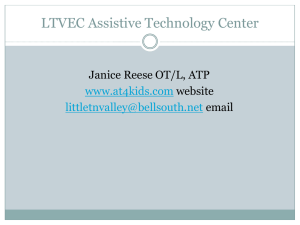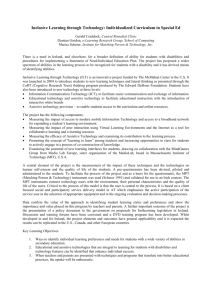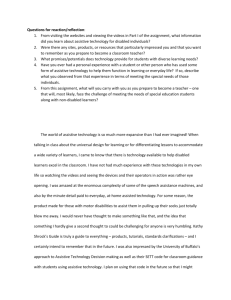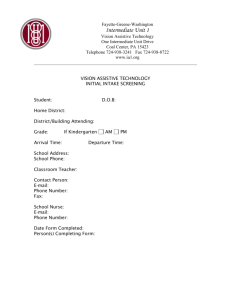The SETT Framework was first introduced at the Closing the Gap
advertisement
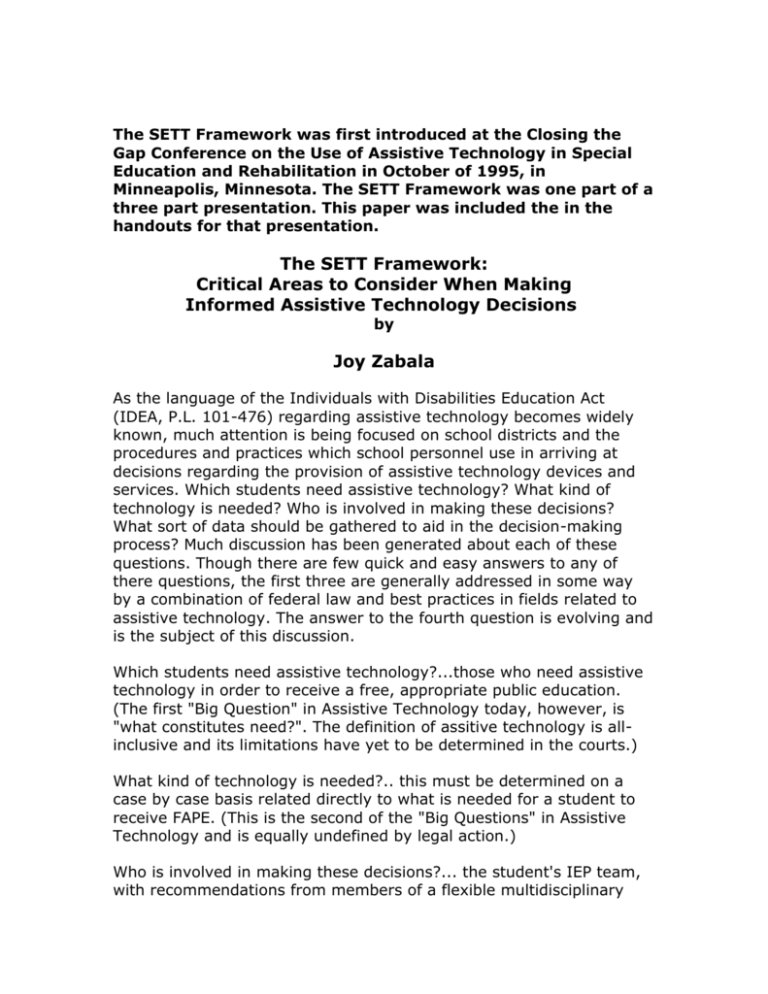
The SETT Framework was first introduced at the Closing the Gap Conference on the Use of Assistive Technology in Special Education and Rehabilitation in October of 1995, in Minneapolis, Minnesota. The SETT Framework was one part of a three part presentation. This paper was included the in the handouts for that presentation. The SETT Framework: Critical Areas to Consider When Making Informed Assistive Technology Decisions by Joy Zabala As the language of the Individuals with Disabilities Education Act (IDEA, P.L. 101-476) regarding assistive technology becomes widely known, much attention is being focused on school districts and the procedures and practices which school personnel use in arriving at decisions regarding the provision of assistive technology devices and services. Which students need assistive technology? What kind of technology is needed? Who is involved in making these decisions? What sort of data should be gathered to aid in the decision-making process? Much discussion has been generated about each of these questions. Though there are few quick and easy answers to any of there questions, the first three are generally addressed in some way by a combination of federal law and best practices in fields related to assistive technology. The answer to the fourth question is evolving and is the subject of this discussion. Which students need assistive technology?...those who need assistive technology in order to receive a free, appropriate public education. (The first "Big Question" in Assistive Technology today, however, is "what constitutes need?". The definition of assitive technology is allinclusive and its limitations have yet to be determined in the courts.) What kind of technology is needed?.. this must be determined on a case by case basis related directly to what is needed for a student to receive FAPE. (This is the second of the "Big Questions" in Assistive Technology and is equally undefined by legal action.) Who is involved in making these decisions?... the student's IEP team, with recommendations from members of a flexible multidisciplinary team which includes the student, family members and/or caregivers, and appropriate educational and related services professionals. This team may also include other people who are significantly involved in the students education and well-being such as medical staff and peers. What sort of data should the multidisciplinary team gather to aid in the decision-making process?... information about the Student, the Environment, the Tasks, and the Tools. For some time people dedicated to meeting the educational and life goals of students with disabilities have been working to identify and provide assistive technology devices with features which match the student's needs and abilities. Good practitioners have gathered extensive data about the student and about assistive technology tools having features which address the student's needs and abilities in the areas of input, process, and output. When this data was gathered and decisions made, devices were acquired, and people were trained on operational techniques, and, with promising frequency, strategies for effective use of the device. Every expectation has been that this would lead to positive changes for students; however, what is frequently seen in the field is assitive technology devices which are underutilized or abandoned, and, therefore, not fostering the growth in communication, participation, and productivity that has been hoped for. Why is this happening? Though the needs and abilities of the student and the features of devices appear to be well-matched, tools are frequently selected with insufficient up-front attention to the environment(s) in which the student is expected to use the assistive technology tools, and to the tasks in which the student is expected to participate within the identified environment(s). It is difficult to choose appropriate tools if there is not a clear awareness of where and how they are to be used! Clearly, it would be unwise for anyone to choose a tool at a hardware store without first considering the task which was to be accomplished with that tool. Without prior planning and reflection, a wonderful saw might be selected and taken home with great pleasure, only to have its owner become quickly disillusioned to find that the saw is of little value when hanging pictures and assembling shelves... two tasks of great importance the purchaser. The most wonderful saw, even one customized to its user's specific body-type, strength, and sawing aptitude is not likely to help with those tasks. Prior attention to what tasks were to be accomplished with the tool would have aided greatly in appropriate tool selection! When considering assistive technology, the environment and the tasks must be considered before tools are selected. To support this belief, the SETT Framework has been developed to aid in gathering and organizing data which can be used to make appropriate assistive technology decisions. The SETT Framework considers, first, the Student, the Environment(s) and the Tasks required for active participation in the activities of the environment, and, finally, the Tools needed for the student to address the tasks. It is important to realize that this outline of questions to consider in each area of the SETT Framework has been developed only as a guideline and a place to start. Teams gathering and acting upon this data may wish to seek answers to numerous additional questions. In virtually every case, the questions will relate to one of the areas of the SETT Framework. The Student What does the Student need to do? What are the Student's special needs? What are the Student's current abilities? The Environment What materials and equipment are currently available in the environment? What is the physical arrangement? Are there special concerns? What is the instructional arrangement? Are there likely to be changes? What supports are available to the student? What resources are available to the people supporting the student? The Tasks What activities take place in the environment? What activities support the student's curriculum? What are the critical elements of the activities? How might the activities be modified to accommodate the student's special needs? How might technology support the student's active participation in those activities? The Tools What no tech, low tech, and high tech options should be considered when developing a system for a student with these needs and abilities doing these tasks in these environments? What strategies might be used to invite increased student performance? How might these tools be tried out with the student in the customary environments in which they will be used? How might one gather the information needed to use the SETT Framework as an aid for effective decision-making? The most commonly used method is the hands-on evaluation in which one or more of the professionals involved in the process take the student through a series of planned exercises or tasks in order to evaluate the student's ability to perform them. This method also may include trying out tools to see which ones the student is able to access physically and cognitively. Though this is a valuable part of the assessment process when used in the student's natural environments, it is important to remember that to view assessment as an event which happens once and is then finished is now generally held to be in error. Current best practices indicate that assessment and intervention are continuous on-going processes and that the initial hands-on evaluation is merely among the first steps. When completing a SETT Framework, several other methods of gathering data are critical. They include: observations of the student involved in the ordinary tasks presented by the natural settings in which the student operates; discussions with the significant people who share those settings with the student; and, possibly, a review of other strategies and tools that have been tried with the student. There are several useful assessment tools available which ask very specific questions about the student's needs and abilities. There are also some environmental inventories available. It would be wise to make use of one or more of them as a guide to seeking and recording the information, always keeping in mind that information gained in observations and discussions is equally valuable. As the data mounts in the on-going assessment process care must be taken that the sheer volume and specificity of the data not obscure the major issues which need to be considered. Organizing the various bits of data under the major SETT headings provides a workable way to see which areas are thoroughly explored and which areas require more work. The SETT Framework supports a thorough yet simple approach to assistive technology assessment and intervention. When data is gathered and organized with simplicity, a team's ability to effectively generate a range of tools which may be tried with the student is greatly enhanced. It is much more likely that the selected system of tools will enhance the student's abilities to address the tasks in which he/she is expected to build competency, thus making the tool more valuable. Equally, it is more likely that the people supporting the student will see the relevancy of the technology as the student grows in competence, confidence, and independence, and thus, be more active in encouraging and supporting the student's achievement through its use. Using the SETT Framework as a guide, it is possible, from the start, to address and overcome many of the obstacles which lead to device abandonment. When the Environment and the Tasks are fully explored and considered, the lament "Well, the device is here, now what do I do with it?" should never be heard. Instead, students, parents, and professionals should all rejoice at the increased opportunities for success which come with assistive technology which is well matched to the student's needs and abilities to perform the natural tasks which are part of living and learning in this world.


